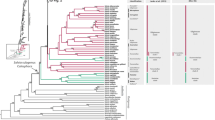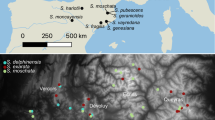Abstract
Salvia divinorum Epl. & Játiva-M. (Lamiaceae) is a potent hallucinogenic plant that is classified within Salvia subgenus Calosphace, section Dusenostachys, and hypothesized to be an interspecific hybrid. It is of ethnobotanical significance due to its employment in traditional healing ceremonies by the Mazatecs of Oaxaca, Mexico, and due to its unique pharmacology—a highly selective, non-nitrogenous, κ-opioid receptor agonist. In order to test its phylogenetic position and putative hybridity, we sequenced multiple DNA regions (ITS, trnL-trnF, and psbA-trnH) of 52 species—representing the major lineages of subgenus Calosphace—and six accessions of S. divinorum. Our molecular phylogenetic results suggest that S. divinorum should not be classified within Dusenostachys and that it is not a hybrid. Additionally, we determine that the closest known relative of this psychoactive Mexican sage is S. venulosa, a rare endemic of Colombia.


Similar content being viewed by others
References
Alberto CM, Sanso AM, Xifreda CC (2003) Chromosomal studies in species of Salvia (Lamiaceae) from Argentina. Bot J Linn Soc 141:483–490
Bentham G (1876) Labiatae. In: Bentham G, Hooker J (eds) Genera Plantarum, vol 2, pp 1160–1222
De Vetancurt A (1698) Teatro Méxicano Descripción Breve de los Sucesos Ejemplares Históricos y Religiosos del Nuevo Mundo de las Indias. Porrúa (1971 printing). México DF, México
Emboden W (1983) The ethnobotany of the Dresden Codex with especial reference to the narcotic Nymphaea ampla. Bot Mus Leafl Harv Univ 29:87–132
Epling C (1939) A revision of Saliva, subgenus Calosphace, vol 110. Repertorium Specierum Novarum Regni Vegetabilis, Beihefte
Epling C, Játiva-M C (1962) A new species of Salvia from Mexico. Botanical Museum Leaflets Harvard University 20:75–76
Felsenstein J (1985) Confidence limits on phylogenies: an approach using the bootstrap. Evolution 39:783–791
Fitch WM (1971) Toward defining the course of evolution: minimum change for a specific tree topology. Syst Zool 20:406–416
Hanes KR (2001) Antidepressant effects of the herb Salvia divinroum: a case report. J Clin Psychopharm 21:634–635
Hanes KR (2003) Salvia divinorum: clinical and research potential. MAPS Bull 13:18–20
Haque MS, Ghoshal KK (1981) Floral biology and breeding system in the genus Salvia L. P Indian Acad Sci B 47:716–724
Harley RM, Heywood CA (1992) Chromosome numbers in tropical American Labiatae. In: Harley RM, Reynolds T (eds) Advances in Labiate science. Royal Botanic Gardens, Kew, London, pp 211–246
Jenks AA (2009) Systematics and ethnobotany of Salvia subgenus Calosphace and origins of the hallucinogenic sage, Salvia divinorum. PhD thesis, University of California, Riverside
Kim S-C, Crawford DJ, Jansen RK, Santos-Guerra A (1999) The use of a noncoding region of chloroplast DNA in phylogeny of the subtribe Sonchinae (Asteraceae). Plant Syst Evol 215:85–99
Maddison WP, Maddison DR (2000) MacClade, Version 4. Sinauer, Sunderland
Neisess KR (1983) Evolution, systematics, and terpene relationships of Salvia Section Audibertia. PhD thesis, University of California, Riverside
Ott J (1995) Ethnopharmacognosy and human pharmacology of Salvia divinorum and Salvinorin A. Curare 18:103–129
Ramamoorthy TP, Elliott M (1998) Mexican Lamiaceae: diversity, distribution, endemism, and evolution. In: Ramamoorthy TP, Bye R, Lot A, Fa J (eds) Biological diversity of Mexico: origins and distribution. Instituto de Biologia, UNAM, Mexico, pp 501–525
Ramamoorthy TP, Esquivel B, Sánchez AA, Rodríguez-Hahn L (1988) Phytogeographical significance of the occurrence of abietane type diterpenoids in Salvia sect. Erythrostachys (Lamiaceae). Taxon 37:908–912
Reisfield AS (1987) Systematic studies in Salvia L. (Lamiaceae) with special emphasis on subgenus Calosphace (Benth.) Benth. section Dusenostachys Epl. MS thesis, University of Wisconsin, Madison
Reisfield AS (1993) The botany of Salvia divinorum (Labiatae). Sida 15:349–366
Reko BP (1945) Mitobotanica Zapoteca. Private Printing, Tacubaya, Mexico
Roth BL, Baner K, Westkaemper R, Siebert D, Rice KC, Steinbert S, Ensberger P, Rothman RB, Salvinorin A (2002) A potent naturally occurring nonnitrogenous κ opioid selective agonist. Proc Natl Acad Sci USA 99:11934–11939
Schultes RE (1940) Plantae Mexicanae II. The identification of teonanacatl, a narcotic Basidiomycete of the Aztecs. Bot Mus Leafl Harv Univ 7:37–54
Schultes RE (1941) A contribution to our knowledge of Rivea corymbosa: the narcotic oloiuqui of the Aztecs. Botanical Museum of Harvard University, Cambridge
Siebert D (1994) Salvia divinorum and salvinorin A: new pharmacologic findings. J Ethnopharmacol 43:53–56
Swofford DL (2002) PAUP*. Phylogenetic analysis using parsimony (*and other methods), version 4. Sinauer Associates, Sunderland
Taberlet P, Gielly L, Pautou G, Bouvet J (1991) Universal primers for amplification of three non-coding regions of chloroplast DNA. Plant Mol Biol 17:1105–1109
Valdés III LJ, Hatfield GM, Koreeda M, Paul AG (1987) Studies of Salvia divinorum (Lamiaceae), an hallucinogenic mint from the Sierra Mazateca in Oaxaca, Central Mexico. Econ Bot 41:283–291
Vortherms TA, Roth BL (2006) Salvinorin A—from natural product to human therapeutics. Mol Interv 6:257
Walker JB, Sytsma KJ (2007) Staminal evolution in the genus Salvia (Lamiacaee): Molecular phylogenetic evidence for multiple origins of the staminal lever. Ann Bot Lond 100:375–391
Walker JB, Sytsma KJ, Treutlein J, Wink M (2004) Salvia (Lamiaceae) is not monophyletic: implications for the systematics, radiation, and ecological specializations of Salvia and Tribe Mentheae. Am J Bot 91:1115–1125
Wasson RG (1961) The hallucinogenic fungi of Mexico, an inquiry into the origins of religious idea among primitive peoples. Bot Mus Leafl Harv Univ 19:137–162
Wasson RG (1962) A new Mexican psychotropic drug from the mint family. Bot Mus Leafl Harv Univ 20:77–84
Weitlaner RJ (1952) Curaciones Mazatecas. Anales Inst Nac Antropol Hist Mexico 4:279–285
White TJ, Bruns T, Lee S, Taylor J (1990) Amplification and direct sequencing of fungal ribosomal RNA genes for phylogenetics. In: Innis M, Gelfand Snisky J, White TJ (eds) PCR protocols: a guide to methods and applications. Academic Press, San Diego, pp 315–322
Wood JRI, Harley RM (1988) The genus Salvia (Labiatae) in Colombia. Kew Bulletin 44:211–278
Walker JB (2006) A preliminary molecular phylogenetic analysis of Salvia subgenus Calosphace, Chap. 3. PhD thesis, submitted to University of Wisconsin, Madison
Yan F, Roth BL (2004) Salvinorin A: a novel and highly selective κ-opioid receptor agonist. Life Sci 75:2615–2619
Acknowledgments
This paper represents a portion of a PhD dissertation submitted to the University of California at Riverside for partial fulfillment of the first author’s doctoral degree. The author’s thank D. Siebert, J. G. Waines, J. T. Columbus, A. Sanders and P. Lubinsky for technical advise and the following herbaria for loaning specimens: University of California, Riverside Herbarium (UCR), University of Wisconsin, Madison Herbarium (WIS), Missouri Botanic Garden (MO), Johannes Gutenberg-Universität, Germany (MJG), and Field Museum of Natural History (FIELD). We also thank two anonymous reviewers for their helpful comments and suggestions on the earlier version of this paper. This project was supported in part by grants from The Botanical Society of America, and the Pacific Rim Association of the University of California.
Author information
Authors and Affiliations
Corresponding authors
Electronic supplementary material
Below is the link to the electronic supplementary material.
Rights and permissions
About this article
Cite this article
Jenks, A.A., Walker, J.B. & Kim, SC. Evolution and origins of the Mazatec hallucinogenic sage, Salvia divinorum (Lamiaceae): a molecular phylogenetic approach. J Plant Res 124, 593–600 (2011). https://doi.org/10.1007/s10265-010-0394-6
Received:
Accepted:
Published:
Issue Date:
DOI: https://doi.org/10.1007/s10265-010-0394-6




